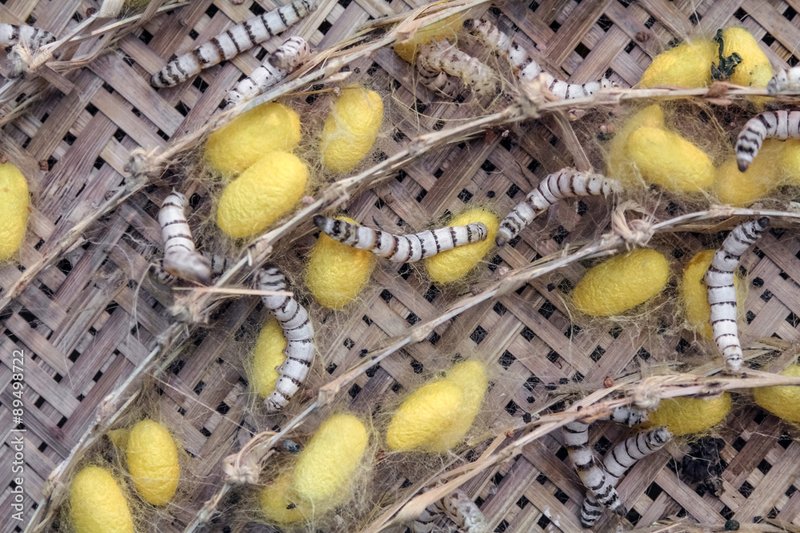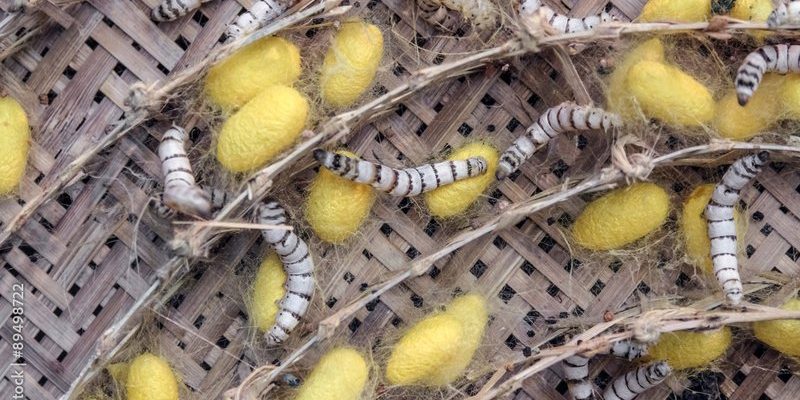
Silkworms, specifically the larvae of the Bombyx mori moth, go through a series of stages to create these cocoons. This transformation is not just about safety; it’s a crucial part of their life cycle that ensures they emerge as beautiful moths. In this article, we’re going to explore the entire process step-by-step. So, grab a cup of coffee, and let’s dive into the enchanting world of silkworms and the magic of cocoon spinning.
The Life Cycle of a Silkworm
Before we jump into the cocoon-spinning stage, it’s essential to understand where silkworms come from. They start their journey as tiny eggs laid by adult moths. After a week or so, these eggs hatch into larvae, commonly known as silkworms.
During this larval stage, which lasts around 4 to 6 weeks, these little guys are on a mission: to eat, grow, and shed their skin multiple times. This process of shedding is called *molting*. They can go through this about 4 to 5 times, which helps them grow larger and prepare for the next phase—cocoon spinning. They feast mainly on mulberry leaves, which provide the nutrients necessary for their transformation.
Once they have matured, silkworms undergo a change in behavior, signaling the shift from feeding to spinning. This transition is natural and crucial for their development. But what exactly happens during the spinning stage?
The Spinning Process Begins
So, you might be wondering, how does a silkworm actually spin a cocoon? Here’s the thing: it doesn’t just dive into it blindly. The spinning process begins when the silkworm finds a safe spot, often on a branch or leaf. This choice is vital for protecting itself once it’s inside the cocoon.
Once settled, the silkworm starts to produce silk. It does this from a special gland in its head known as the salivary gland. The silk starts out as a liquid, and as the silkworm secretes it, it hardens into threads when exposed to air. It’s kind of like those apps that let you spin a web of creativity—except in this case, the silkworm is creating a protective home.
As it spins, the silkworm moves its head in a figure-eight pattern, layering silk around itself. This method forms a strong, durable cocoon. You might find it interesting that a single silkworm can produce up to 1,000 meters of silk thread by the time it’s finished!
Now that we know how silkworms start spinning, let’s chat about the cocoon’s structure. The cocoon itself is fascinating—it’s not just a simple covering. Instead, it’s made up of strands of silk that are incredibly strong and lightweight.
The outer layer of the cocoon is typically more coarse, providing initial protection. As you peel back the layers (figuratively speaking, of course), the inner silk is finer and smoother. This dual-layer design is like wrapping the silkworm in a cozy blanket that keeps it safe from predators and environmental dangers.
Interestingly, the color of the cocoon can vary based on the species of silkworm and the conditions in which it spins. Most silkworm cocoons are a creamy white color, but they can also be yellow or even brown. This diversity adds to the beauty of silk, making it not just a practical product but also a desirable fabric.
The Purpose of the Cocoon
You might be asking yourself, “Why go through all of this trouble?” Well, the cocoon serves a vital purpose. It’s not only a protective layer but also a safe space for the silkworm to undergo metamorphosis. Once inside the cocoon, the silkworm transforms into a moth.
During this stage, the silkworm undergoes significant changes. Its body develops wings, and it gains all the features typical of adult moths. This entire process can take about 10 to 14 days. When it’s finally ready, the moth breaks free from the cocoon, ready to start a new chapter in its life.
Interestingly, the cocoon also sets the stage for one of the oldest industries in the world: silk production. While the moths can emerge freely, many cocoons are harvested for their silk, contributing to a rich tradition of silk-making that has persisted for centuries.
The Harvesting of Silk
Now, let’s touch on what happens once the cocoons are spun and ready for harvest. For those who work in the silk industry, it’s an essential time. Harvesting involves carefully collecting the cocoons before the moths emerge. This is crucial because, once the moth breaks free, it damages the silk thread, making it unusable for fabric production.
Typically, farmers will place the cocoons in hot water or steam to kill the pupae inside. This helps prevent them from breaking out and ensures the silk strands remain intact. After that, the silk is unwound from the cocoon, often resulting in long, continuous threads that can be woven into fabric.
This process has been refined over thousands of years, blending tradition with technology. Today, organizations around the world use different equipment and techniques to maximize silk production while keeping sustainability in mind. It’s a fascinating blend of nature and human innovation.
Silkworms are incredible little creatures, and the way they spin cocoons is a testament to the marvels of nature. From the larval stage to the final transformation into a moth, each step plays a crucial role in their life cycle. The cocoon isn’t just a protective structure; it’s a cozy home where they undergo significant changes, ultimately paving the way for a new generation to start the cycle all over again.
Next time you see a beautiful silk garment, remember the hardworking silkworms behind it. Their intricate spinning process is a beautiful reminder of nature’s creativity and resilience. Isn’t it amazing to think about how such small creatures can have such a big impact on our lives?

